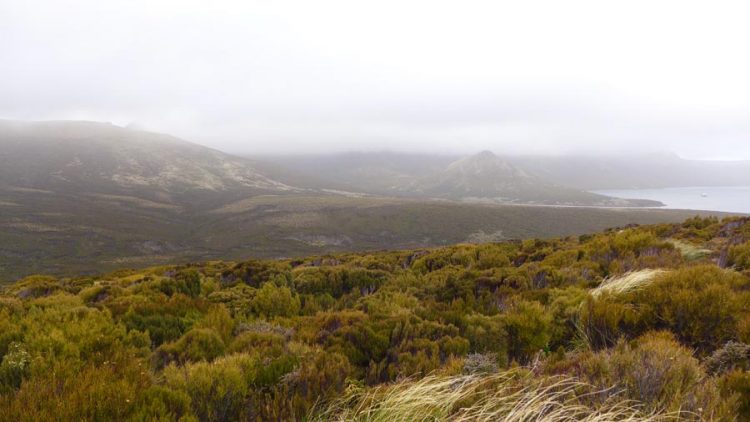Shrub growth decreases as winter temps warm up

Photo by Janet Wilmshurst Dracophyllum on Campbell Island, New Zealand.
“When winter temperatures fluctuate between being cold and warm enough for growth, plants deplete their resources trying to photosynthesize and end the winter with fewer reserves than they initially had. In the summer they have to play catch up,” said Melanie Harsch, a University of Washington postdoctoral researcher in biology and applied mathematics. She is lead author of a paper on the subject recently published in PLOS One.
The roots are especially sensitive to temperature fluctuations, Harsch said. Warming winters result in higher root respiration, which uses up carbon reserves as plants make and release oxygen, leading to less carbon available during the regular growing season.
Harsch and her colleagues studied two species of shrubs on Campbell Island, an uninhabited UNESCO World Heritage site in the southwest Pacific Ocean about 375 miles south of New Zealand’s mainland. They studied two large shrubs, Dracophyllum longifolium and Dracophyllum scoparium, which are evergreen broadleaf species that can grow up to about 15 feet tall and live up to 240 years.
Researchers found that while warmer, drier winters helped seedlings get established, it adversely affected growth of older plants.
“For growth to occur you need sufficient precipitation and temperature and nutrients. Growth should only happen during the summer on Campbell Island when temperatures are above 5 degrees Celsius,” Harsch said. Five degrees C is about 40 F. “On Campbell Island most winters are cool and below this 5 degrees Celsius, so the plants are not active. The plants we studied are evergreen and there is little snow cover, so they are sensitive to changes in temperature.”
In this study, researchers cut out discs, called “cookies,” from just above the shrubs’ root collar, and measured the width between each ring to determine growth. They found that plant growth decreased as winter temperatures went up.
“On Campbell Island the snow is ephemeral, so the plants usually are not covered,” Harsch said. “If we’re going to see an effect in changing winter conditions, we’re going to see it at Campbell Island decades before we see it at, say, Mt. Rainier, where there is a lot of snow and winters are colder.”
Harsch said plants in areas like Campbell Island may eventually adjust to warmer winters, but the transition period will be tough as temperatures bounce above and below what plants need to stay dormant, causing the plants to draw down their resources.
“It may eventually be warm enough in the winters so that plants can photosynthesize and grow year round, like they do in the tropics,” she said. “It’s this transition part that plants are not adapted for.”
Harsch plans to do a follow-up study that would measure the microbes and carbon reserves in the soil, and manipulate snow packs to see how it affects establishment and growth.
“How much of this can our tree species withstand?” Harsch said. “Will summer growth eventually compensate for these hard winters, or is this some sort of extra stressor on trees that will be one more nail in the coffin? If you think of all the different factors of increasing vulnerability in climate change, is this really significant? We just don’t know.”
Co-authors are Matt McGlone and Janet Wilmshurst at Landcare Research in New Zealand. Harsch started the work while pursuing her doctorate at Lincoln University in New Zealand and finished the analysis at the UW. The work was supported in part by the National Science Foundation.
# # #
For more information, contact Harsch at harsch.melanie@gmail.com or 253-365-1555.
NSF grant: DEB-1103734.
Media Contact
All latest news from the category: Life Sciences and Chemistry
Articles and reports from the Life Sciences and chemistry area deal with applied and basic research into modern biology, chemistry and human medicine.
Valuable information can be found on a range of life sciences fields including bacteriology, biochemistry, bionics, bioinformatics, biophysics, biotechnology, genetics, geobotany, human biology, marine biology, microbiology, molecular biology, cellular biology, zoology, bioinorganic chemistry, microchemistry and environmental chemistry.
Newest articles

“Nanostitches” enable lighter and tougher composite materials
In research that may lead to next-generation airplanes and spacecraft, MIT engineers used carbon nanotubes to prevent cracking in multilayered composites. To save on fuel and reduce aircraft emissions, engineers…

Trash to treasure
Researchers turn metal waste into catalyst for hydrogen. Scientists have found a way to transform metal waste into a highly efficient catalyst to make hydrogen from water, a discovery that…

Real-time detection of infectious disease viruses
… by searching for molecular fingerprinting. A research team consisting of Professor Kyoung-Duck Park and Taeyoung Moon and Huitae Joo, PhD candidates, from the Department of Physics at Pohang University…





















